‘Get down and row’ | Sports Features
Day three of the Grand Canyon trip broke about 5 a.m., as a moonlit night gave way to a clear morning and Matt Hansen fired up a pot of strong cowboy coffee. Hansen and a group of friends were about to enter the Roaring Twenties, a stretch of 10 rapids in 10 miles, all rated moderate difficulty. The mood was light and cheerful: The previous day the party of five rafts had navigated House Rock, a more notorious rapid that had been tight but forgiving.
The trip leader touted a “really fun” day of whitewater ahead. One participant donned a flapper dress with her life jacket, a festive nod to the Roaring Twenties (the name refers to the mileage of the river below the put-in at Lee’s Ferry, as well as the lively waves).
The Colorado River was running a little more than 6,000 cubic feet per second. By late morning the group reached the heart of the stretch: seven rapids spaced roughly a half-mile apart and all rated 4 to 6 on the Grand Canyon scale of 1 to 10.
David Stubbs rows through a small rapid on the Colorado River during a recent 16-day trip through the Grand Canyon. Stubbs and friends from Jackson rowed five rafts 225 miles from Lee’s Ferry to Diamond Creek. Flows fluctuated each day between roughly 6,000 and 9,000 cubic feet per second.

Reed Finlay, center, and fellow rafters scout the fearsome Hance Rapid.
Indian Dick Rapid at mile 23 appeared to be a one-and-done drop — except that drop turned out to be at least twice as big as Big Kahuna on the Snake. Georgie at mile 24 packed an equally sharp wallop, along with a few rocks and holes to dodge. Then came Tiger Wash at mile 27, where big waves were bookended on each side by powerful, swirling eddies, one of which swallowed up a paddler in an inflatable kayak and spit him out downstream, separated from the boat.
As his wife, Andi, hung on to their raft, Hansen rowed furiously through each of the cataracts, bracing for the crash and narrowly avoiding the holes. The group recovered the kayaker, a bit shaken from the swim, and at the bottom of the rapid navigated a slalom course through a rock garden of sandstone boulders.
Hansen and the other rowers were wide-eyed. These were not the infamous rapids of the Grand Canyon that strike fear in boaters’ hearts: Lava Falls, Crystal Rapid, Horn Creek, all of which are rated 8 to 10 in difficulty. The sandstone boulders, rising 4 or 5 feet out of the muddy water, were an obvious sign of drought taking its toll. At 6,000 cfs, the mighty Colorado would be small, tight and technical in many places that otherwise would be easier, or underwater, at higher flows.
“For me the big surprise was Tiger Wash,” Hansen said. “I think that really drove home that this was not an ordinary river. It was so much stronger than anything I had done before, even high water on the Snake.”
October is a coveted time for a Grand Canyon permit, and boaters often wait years to secure a launch. At least a half-dozen trips from Jackson Hole ran the canyon this fall and learned the same lessons about low water.

The sun peeks over the canyon rim at Nankoweap, site of an Anasazi granary in the cliff at right.

Rafts tied up on shore at Nankoweap, following a thunderstorm that sent small creeks rushing through camp and waterfalls cascading over the opposite canyon rim. Foam from runoff is visible in the deep red water of the river.
A day or two in front of Hansen’s party, Matt “Dutch” VanderPoel and friends had a similar experience through the Roaring Twenties.
“Indian Dick punched us right in the face,” VanderPoel said. “If you don’t hit it straight on, it could flip a big boat.”
Two weeks later Bill Guheen, the longtime Grand Teton Lodge Co. river boss, came down with a group of his former and current boatmen. This was Guheen’s fifth trip through the canyon; the first was in 1984.
“A lot of the waves were fairly sharp and they punched you. They didn’t let you run through,” Guheen said. “A lot of the ‘riffles’ became rapids.”
If riffles were rapids, and moderate rapids were difficult and required scouting, what did that mean for the menacing drops yet to come? Members of Hansen’s party couldn’t help but wonder as they churned forward on the oars, more than a mile deep in a granite gorge that evoked Mordor or the 1970s TV show “Land of the Lost.”
Major John Wesley Powell’s pioneering voyages in 1869 and 1871 — from which he compiled his book, “The Exploration of the Colorado River and Its Canyons” — remain the yardstick by which every Grand Canyon trip is measured. Given the daunting sight of bony rapids in low water, his famous words still rang true: “We have an unknown distance yet to run; an unknown river yet to explore … With some eagerness, and some anxiety, and some misgiving, we enter the canyon below …”

Participants on the rafting trip stop to explore Redwall Cavern, a landmark carved out by the Colorado River. The cavern is so large that pioneering explorer John Wesley Powell estimated it could hold 50,000 people.

Fossils of prehistoric squid can be seen in the rock at Nautaloid Canyon.
Or in the music that later would play at Hansen’s camp at night, Jerry Garcia softly crooning, “Row, Jimmy, row. Gonna get there? I don’t know … Get down and row.”
Communications director for the Teton County Search and Rescue Foundation and host of the “Fine Line” podcast, Hansen is no stranger to epic adventures. The former Powder magazine editor guided on the Snake in the mid- to late-1990s in Grand Teton National Park, where he learned to read water steering 30-foot sweep boats under the tutelage of Guheen. He has since run many stretches of the Green and other rivers around the West.
In rowing 225 miles from Lee’s Ferry to the Diamond Creek takeout in 16 days, safely navigating nearly 100 rapids, he and his comrades relied on every bit of their training and experience.
“I couldn’t even relax on the oars,” Hansen said. “You had to be on it, every rapid, every eddy line; you had to be paying attention.”
With Lake Powell at its lowest level since the completion of Glen Canyon Dam in 1963, down 171 feet, federal water managers have been taking unprecedented steps to confront severe drought, climate change and the reality that water in the Colorado River is oversubscribed. This year the U.S. Bureau of Reclamation moved an additional half-million acre feet from Wyoming’s Flaming Gorge Reservoir to “protect” Lake Powell’s capacity to generate hydropower, and reduced the release from Glen Canyon Dam by an additional half-million acre feet — resulting in an October flow at Lee’s Ferry fluctuating daily between 6,000 and 9,000 cfs, based on power generation.
Since the construction of Glen Canyon Dam there have been other times when the release was lower in October — dam management is highly complex — but generally the daily high tide was much higher in those cases. This year’s flow was 15% to 25% below the long-term median.

Ian Horn takes a turn on the oars alongside a limestone cliff. Low releases from Glen Canyon Dam made for some new features and tighter routes through the canyon. Strange currents often pushed boats toward cliffs or lurking rocks.
The trends are ominous. There’s only another 39 feet before Lake Powell would be unable to generate electricity at all, and WyoFile reported this week that Cheyenne, Wyoming’s capital city, could lose 70 percent of its water supply as soon as 2028, if states are forced to cut use.
Is this the new normal for the Colorado River? And if so, is it getting harder to run the Grand Canyon?
“That’s a question that a lot of private boaters and river guides are asking themselves right now,” said Kevin Fedarko, author of “The Emerald Mile,” the gripping account of the fastest run through the canyon and authoritative treatise on the history and culture of the river.
“The answer is yes and no. Runs are becoming more challenging in many, many ways. It is becoming bonier and becoming more technical. All sorts of problems are arising that nobody ever had to worry about.”
At the same time there is less power in the current at some of the biggest rapids like Lava or Crystal. “There’s more time,” Fedarko said. “More time to react and make a decision, form a plan.”
Lorna Corson and her husband, Norm Larson, are longtime Grand Canyon guides who live south of Wilson. Corson started guiding for Arizona Raft Adventures, or AzRA, in 1978. She recalls some low autumn flows in her early years, but “I’ve never seen this kind of low water until now,” she said. “It’s definitely changing, and it’s changing fast.”

Chorizo master Matt Hansen prepares a hearty egg breakfast at camp. Hansen ran the canyon for the first time, after many other Western river trips.

Dutch oven cornbread really satisfied after a long day on the river.
Corson guided a commercial trip in late September and October. Tiger Wash “used to be nothing, but now it’s nasty,” she said. “There are really weird hydraulics there that can suck you so far down. With a life jacket you eventually pop up, but it’s no place to mess around. There’s no strategy, either; you enter and see what happens.”
The canyon is an incredibly dynamic ecosystem that’s constantly evolving. Storms witnessed by the Jackson trips this fall attest to the erosive power that has shaped the walls and continues to sculpt the rapids.
What’s changed, Fedarko, Corson and others say, is that while monsoon flash floods continue to bring enormous flows of debris from side canyons into the Colorado, squeezing the channel and depositing boulders, the main stem of the river no longer regularly floods with 100,000 cfs or more during spring runoff. Anemic dam releases don’t wash out as much debris from the side canyons, and also don’t flush beaches and redistribute sand — leaving more mud for rafters to slog through as they leave boats for camp.
“Some rapids like Bedrock are becoming devilishly more difficult,” Fedarko said.
Indeed, Bedrock Rapid, just past mile 130, was the site of a fatality this summer, a rarity in the canyon, when a passenger on a commercial motorized trip died in a flip. While there always has been a massive island of schist to pull away from, flash floods down Bedrock Canyon have reduced the size of the right channel where boats must pass, making for a tight — and highly consequential — squeeze. Corson pulled over to scout there on her last trip, which she usually doesn’t do, and was glad she did.

Rebecca Huntington swims at the mouth of Havasu Creek where it enters the Colorado River.
Fedarko, who has done 15 or so rafting trips through the canyon and is working on a new book about walking the length of it, cautioned that although boaters had come to rely on them, consistently strong flows of cold, clear water are a relatively recent phenomenon on the Colorado, a product of dam operation. Before 1963 the river would run wild in spring for six weeks or so, and occasionally would rise with monsoon flooding, but otherwise would be low, slow, warm and silty.
“This is just the tip of the iceberg,” Fedarko said. “What appears to be a dewatered river right now is actually going to look pretty flush in a few years.”
Given the rapidly draining reservoirs, some of the talk around camp at night inevitably turned to the future of the river. “What happens when it gets down to 800 cfs and you have to pack raft it?” VanderPoel said.
Adam Meyer, one of the rowers on Guheen’s trip, echoed that sentiment. “I fear that within our lives the era of 365 days of launches and navigable water might end,” he said.
Corson, the Grand Canyon guide, said while she is nearing the end of her career, she, too, worries about the industry.
“It’s messed up,” she said. “I don’t know if they can run motor boats down there much longer. People can always kayak it and run duckies, but I don’t know about commercial trips.”
All of the various Jackson Hole trips made it safely through the canyon last month, despite mishaps at Bedrock, Horn and Hance rapids. Those stories will be shared over campfires and bar counters for years to come.
As Fedarko noted, some of the biggest rapids turned out to be a bit kinder in low water. Lava Falls at mile 179, perhaps the most fearsome and fabled rapid, had a mountainous wave near the end but often slid boats left or right of it.
Still, for VanderPoel, who did not have much previous rowing experience, the run was a highlight: “Not being an oarsman, not having even rowed the [Snake] canyon here, I had a lot of anxiety about rowing the big ones,” he said. “By the time I got to Lava, I had a lot of confidence. I stuck it. There was no going left or right.
“I almost broke down crying, I was so elated. It was the biggest rush ever to stick that thing.”

David Stubbs shows a trophy he took home after a miscue in Hance Rapid.
Low water required more pushing on the oars when there was little current, more time hiking over rocky terrain to scout rapids, more stamina for setting up and breaking down camp and rigging boats when shoulders, hands and backs were sore. “Every waking hour passed in the Grand Canyon has been one of toil,” Powell wrote in his account.
Photographer David Stubbs, who was part of Hansen’s trip and rowed one of the rafts, called the workout “the biggest beatdown unlike anything I’ve ever experienced in my life.” Participants of the various trips are still recovering.
Despite the toil and the pain, the river runners came home savoring the type of elation VanderPoel spoke of. The quality of the camping — shorts and T-shirts every night, barefoot in the sand — the satisfaction of accomplishing the feat, and the sublimity of spending weeks deep in the heart of the desert wilderness more than made up for the difficulty. “Our joy is almost ecstasy,” as Powell wrote.
Some rafters came home with more than great memories. “I’ve had three showers,” Guheen said a day after taking out. “On the third one, I finally got where my scalp felt clean and didn’t have any sand in it.”
————————————————

Grand Teton Lodge Co. river boss Bill Guheen has worked five decades on the Snake.
Guheen marks 50 years with GTLC
For Bill Guheen, rafting the Grand Canyon last month was icing on the cake after finishing his 50th season on the Snake River with Grand Teton Lodge Co.
Guheen, 73, started as a boatman with the Lodge Co. in the park in 1968. For many years he has been the “river boss,” overseeing the float trip operation as well as guiding.
The recent trip was his fifth through the Grand Canyon. His first was in 1984, when he, his brother Tom and friends borrowed four old rafts from Charlie Sands, made their own oars and “just winged it” down the Colorado.
This was the first time he didn’t row the entire trip, as he had younger guys – some of his former and current Lodge Co. boatmen – to do most of the rowing, and he would take a guest turn at the oars. But after he fell out of the boat twice, he said the younger guys must’ve come up with a new game: “River Boss Toss.”
His wife, Janet Monahan, secured the permit and was trip leader.
Grand Teton Lodge Co. threw a party in Guheen’s honor on Labor Day weekend, as colleagues from throughout his five decades shared stories and raised glasses of Glenlivet in his honor.
“It’s an unusual accomplishment for anyone in any career,” said veteran boatman Wayne Johnson, who trained Guheen and has had the pleasure of working with him (and for him) for decades. He praised Guheen for adapting to all of the changes in the company as well as the rafting industry.
When Guheen started, the Lodge Co. ran 30-foot pontoon boats from Jackson Lake Dam to Moose. Those crafts, fitted with a rudder on each end and known as sweep boats, are likely being retired on the Snake, as facilities are renovated and logistics change. But Guheen has been steadfast in using them to train generations of guides to read water and navigate braided channels.
“Over the years I’ve been real lucky with the guides I’ve worked with, all the kids who’ve come out here,” he said. “Sometimes the parents show up and say, ‘Hey, you turned my boy into a man because you gave him the responsibility to go out there and float the Snake.’
“It’s a rewarding feeling, knowing you’ve been connected with all these people over the years.”
Guheen is looking ahead to a 51st season, as long as his body can take it, and possibly even another Grand Canyon trip sometime in the future. “I’m thinking I should go make enough money to do a commercial permit, where they do everything,” he said.



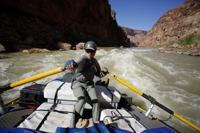
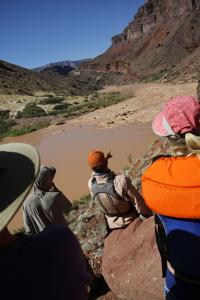

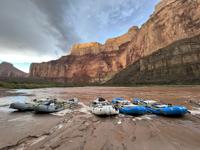


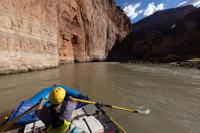
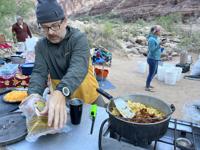
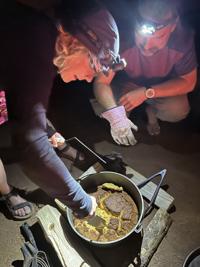
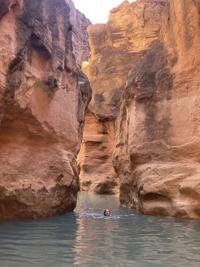
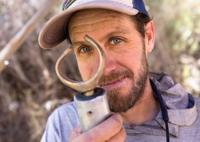
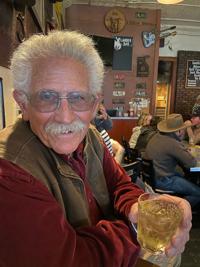
Comments are closed.